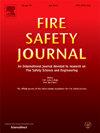Lateral flame spread over thermally thin Fuels: Theoretical prediction of spread rate and experimental validation with PMMA and cellulosic fuels
IF 3.4
3区 工程技术
Q2 ENGINEERING, CIVIL
引用次数: 0
Abstract
Flame spread over solid fuel is a fundamental problem in fire safety science. Although it has been studied in different orientations – downward, upward, horizontal, and lateral– closed-form formulas for predicting the flame spread rate were first proposed for the opposed-flow configuration and experimentally verified in downward configuration, a special case of opposed-flow flame spread. In this work we present a simplified theory to predict the flame spread rate when a vertical flame spreads sideways (laterally) on both sides (symmetrically) of a thermally thin sample held horizontally in a quiescent normal-gravity environment. The ratio of flame spread rates between the lateral and downward orientations are shown to depend only on the flame coefficient, a non-dimensional known temperature ratio, and the Prandtl number. Experiments are performed in both downward and lateral configurations with a series of PMMA (Poly-methyl metacrylate) samples with fuel thickness ranging from 400 through 1500 μm and width from 10 through 60 mm as parameters. Similar experiments are also performed with ashless filter paper. The spread rate ratio between the two configurations is compared to the theoretical prediction with reasonable agreement. As predicted by the theory, the spread rate ratio is found to be independent of fuel thickness and fuel width for laminar flame spread.
横向火焰在热薄燃料上的传播:传播率的理论预测和PMMA和纤维素燃料的实验验证
固体燃料上的火焰蔓延是火灾安全科学中的一个基本问题。虽然已经在不同的方向——向下、向上、水平和横向——进行了研究,但预测火焰蔓延速度的封闭形式公式是首先针对对流构型提出的,并在对流火焰蔓延的特殊情况下向下构型进行了实验验证。在这项工作中,我们提出了一个简化的理论来预测当垂直火焰在静止的正常重力环境中水平保持的热薄样品的两侧(对称)横向(横向)传播时的火焰传播速率。横向和向下方向之间的火焰蔓延率之比仅取决于火焰系数、无量纲已知温度比和普朗特数。实验采用了一系列PMMA(聚甲基丙烯酸甲酯)样品,燃料厚度从400到1500 μm,宽度从10到60 mm为参数,在向下和侧向配置下进行。用无灰滤纸也进行了类似的实验。将两种结构之间的扩散速率比与理论预测进行了比较,结果符合较好。正如理论预测的那样,层流火焰扩散速率比与燃料厚度和燃料宽度无关。
本文章由计算机程序翻译,如有差异,请以英文原文为准。
求助全文
约1分钟内获得全文
求助全文
来源期刊

Fire Safety Journal
工程技术-材料科学:综合
CiteScore
5.70
自引率
9.70%
发文量
153
审稿时长
60 days
期刊介绍:
Fire Safety Journal is the leading publication dealing with all aspects of fire safety engineering. Its scope is purposefully wide, as it is deemed important to encourage papers from all sources within this multidisciplinary subject, thus providing a forum for its further development as a distinct engineering discipline. This is an essential step towards gaining a status equal to that enjoyed by the other engineering disciplines.
 求助内容:
求助内容: 应助结果提醒方式:
应助结果提醒方式:


